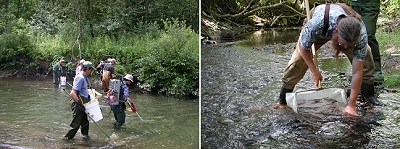Overview

The primary function of the Biomonitoring and Aquatic Studies (BASS) staff is to conduct environmental monitoring of aquatic resources, with an emphasis on the assessment of biological integrity. Activities include: the collection, processing and analysis of biological samples; the assessment of physical habitat features; the collection of chemical water quality samples; the assessment of monitoring data results to ensure that data are of the highest possible quality and that the assessment results are appropriately integrated into a wide variety of DEC management programs. BASS conducts more than 100 comprehensive biological assessments annually, with emphasis on evaluation of fish and aquatic macroinvertebrate communities in running waters. BASS provides information and technical assistance to many DEC permit, regulatory, and management programs. BASS also conducts special studies in areas of special concern such as acid rain, malformed frogs, aquatic nuisance control and seasonal pools.
Biomonitoring
- Introduction
- Data. Use the Site Search for all biological and chemical data
- Ambient Biomonitoring Network
- How Does the VT DEC Use Biomonitoring?
- Ambient Biomonitoring Network Quality Assurance Project Plan
- Links of Interest
Introduction
Vermont DEC routinely surveys the macroinvertebrate and fish communities of lakes, wetlands, rivers, and streams in order to evaluate the biological health, or biological integrity, of the resource surveyed. This type of survey is called biomonitoring or biosurveying.
Comprehensive pollution assessment requires various types of data. Biosurvey techniques (ie biomonitoring), are best used for detecting aquatic life impairments and assessing their relative severity. Once an impairment is detected, however, additional ecological data, such as chemical and biological (toxicity) testing is helpful to identify the causative agent, its source, and to implement appropriate mitigation. Integrating information from these data types as well as from habitat assessments, hydrological investigations, and knowledge of land use is helpful to provide a comprehensive diagnostic assessment of impacts from the 5 principal factors affecting biological health in aquatic systems (water quality, habitat structure, energy source, flow regime, and biotic interaction factors).
Following mitigation, biosurveys are important for evaluating the effectiveness of such control measures. Biosurveys may be used within a planning and management framework to prioritize water quality problems for more stringent assessments and to document "environmental recovery" following control action and rehabilitation activities. Some of the advantages of using biosurveys for this type of monitoring are:
- Biological communities reflect overall ecological integrity (i.e., chemical, physical, and biological integrity). Therefore, biosurvey results directly assess the status of a waterbody relative to the primary goal of the Clean Water Act (CWA).
- Biological communities integrate the effects of different stressors and thus provide a broad measure of their aggregate impact.
- Communities integrate the stresses over time and provide an ecological measure of fluctuating environmental conditions.
- Routine monitoring of biological communities can be relatively inexpensive, particularly when compared to the cost of assessing toxic pollutants, either chemically or with toxicity tests.
- The status of biological communities is of direct interest to the public as a measure of a pollution free environment.
- Where criteria for specific ambient impacts do not exist (e.g., nonpoint-source impacts that degrade habitat), biological communities may be the only practical means of evaluation.
Ambient Biomonitoring Network (ABN)
The Ambient Biomonitoring Network (ABN) program was established by the Vermont DEC in 1985 to:
- monitor long-term trends in water quality as revealed in changes over time to ambient aquatic fish and macroinvertebrate communities
- to evaluate site-specific impacts of point and non-point discharges to aquatic biological communities, and
- to establish baseline data to assist the Department in establishing Vermont-specific biological criteria for water quality classification attainment determinations in rivers and streams.
How Does the VT DEC Use Biomonitoring?
Since 1985, the Department has used standardized methodologies for sampling fish and macroinvertebrate communities, evaluating physical habitat, processing samples, and analyzing and evaluating data. The program has led to the development of a Vermont-specific fish community Index of Biotic Integrity (IBI) and guidelines for determining water quality classification using macroinvertebrate community biological integrity metrics. A detailed account of the development of stream biocriteria for wadeable-sized Vermont streams is available in the recently revised Wadeable Stream Biocriteria documents listed below:
- Executive Summary: Biocriteria for Fish and Macroinvertebrate Assemblages in Vermont Wadeable Streams and Rivers - Development Phase
- Biocriteria for Fish and Macroinvertebrate Assemblages in Vermont Wadeable Streams and Rivers - Development Phase
- Biocriteria for Fish and Macroinvertebrate Assemblages in Vermont Wadeable Streams and Rivers - Implementation Phase
Biological monitoring methods are used to assess impacts of waste water treatment plants on streams but also impacts from logging, acid rain, drawdowns on lakes, agricultural practices, removal of stream side vegetation and the effects of exotic species on natural populations.
The composition and density of organisms in aquatic communities responds proportionately to a range of impact. The greater the disturbance source is, the greater the response of the community. The VT DEC has developed what is called the reference expectation. This simply is a standard of comparison by which we compare all sites to. We have developed a set of community characteristics (called metrics) that reflect a healthy waterbody (a community which has evolved in a watershed with little disturbance from human activity). The severity of the impact is directly measured by the degree of change in various metrics from the reference expectation. The extent of change or departure from the reference expectation is directly linked to the water quality classes contained in the Vermont Water Quality Standards.
Biological monitoring methods are used not only to assess impacts of waste water treatment plants on streams but also impacts from logging, acid rain, drawdowns on lakes, agricultural practices, removal of stream side vegetation and the effects of exotic species on natural populations.
Check out the current locations where the BASS staff have found crayfish in Vermont.
